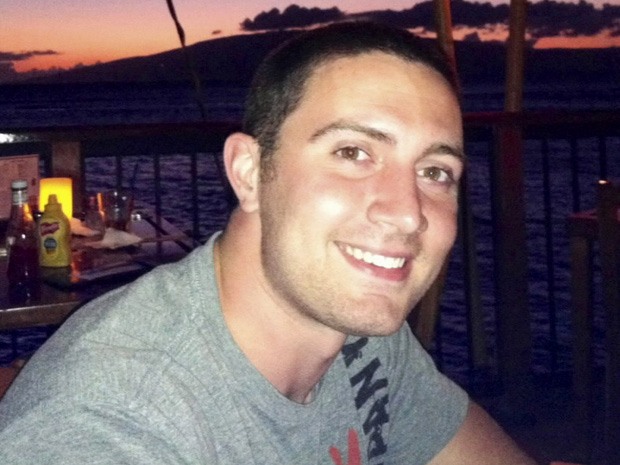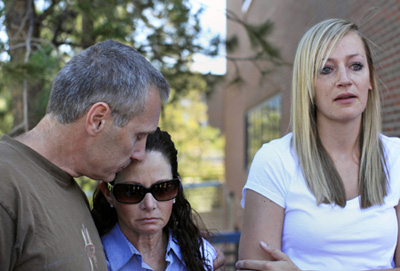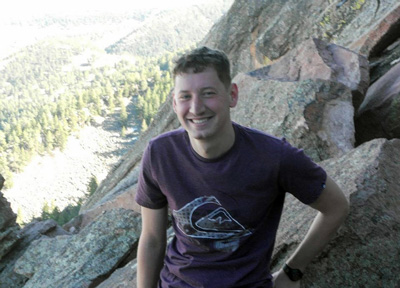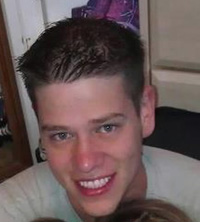
Teves Family / Family photos / Reuters
Alex Teves was killed while protecting his girlfriend, Amanda Lindgren during the Colorado theatre shooting.

REUTERS/Shannon Stapleton
Alex Teves' parents Tom and Caren and his girlfriend Amanda Lindgren.
As a gunman tore through a Colorado movie theatre last week, four men shielded their girlfriends from harm — each taking a fatal bullet. One young woman kept her best friend alive by applying pressure to a gunshot wound. When the gunfire stopped, a 13-year-old girl tried desperately to give her six-year-old friend CPR.
The tales of heroism are serving as a balm for survivors and a nation whose faith in humanity has been rattled. And in the aftermath of last week’s gun massacre in Aurora, Colo., those who study altruism and risk know this: Heroes are not born — they’re made.
It’s not just one human quality that predicts whether a person would leap into the line of fire to save another, said Ervin Staub, a professor of psychology emeritus at the University of Massachusetts and author of The Psychology of Good and Evil: Why Children, Adults and Groups Help and Harm Others.
It requires a combination of socialization and experience helping others.
Related
-
Dark Knight Rises star Christian Bale visits Colorado to pay respects to shooting victims
-
Fund for Colorado shooting victim latest example of Internet's fundraising power
-
Friend made ‘heroic’ attempt to save aspiring sportscaster Jessica Ghawi in chaotic Aurora theatre
Boys and girls are usually raised to be caring, to think about others before themselves, he said. They develop empathy and put it in action through helping others. The 13-year-old hero in Aurora, Kaylan, had helped at a homeless shelter in the past and once shaved off her hair for a cancer drive, he pointed out.
A person must also be competent enough to act in emergency situations, like the one in Aurora.
Not everyone is so “action oriented,” Mr. Staub said.
“Some people, I think, have all the elements that helping [requires] — they care about others, they have a feeling of effectiveness, they may have developed through experience an action orientation — like, for example, that army veteran,” he said, referring to 26-year-old Jonathan Blunk who, just like Navy officer John Larimer, died protecting the girl he had brought with him to the movie.

Larimer family / The Associated Press
John Larimer died protecting the girl he had brought with him to the movie.
During army and naval training, they’re taught to respond to danger in this way, he said — immersed in a culture of sacrifice for their brothers and their country.
When a person has all of these qualities, his or her decision-making process can be “automatic” in a moment of crisis, added Mr. Staub, which is why many heroes can’t explain what spurred them to action.
“Alex didn’t even hesitate,” Amanda Lindgren told ABC News about her boyfriend Alexander Teves. “I sat there for a minute, not knowing what was going on, and he held me down and he covered my head and he said, ‘Shh. Stay down. It’s OK. Shh just stay down.’ So I did. He would do anything for me. He always told me that too.”
Mr. Teves, who had just earned his masters degree in counselling psychology, was killed in the gunfire.
Matt McQuinn, a 27-year-old from Ohio who met his girlfriend Samantha Yowler while working at a Denver Target store, threw himself on top of her to protect her from the bullets.

Blunk Family / AFP / Getty Images
Jonathan Blunk, 26
Ms. Yowler was shot in the knee. Mr. McQuinn didn’t survive.
A man might leap in front of his wife or girlfriend because they’re socialized to put women first, Mr. Staub said. That may hold their “male self-concept” intact.
“Imagine how they would feel if that girlfriend jumped over them and tried to protect them?”
There is a human instinct that drives us to act on behalf of the people we care about, starting from that maternal and paternal instinct to protect and extending to spouses and lovers, said Mike McCullough, a professor of psychology at the University of Miami and author of Beyond Revenge: The Evolution of the Forgiveness Instinct.
“The way natural selection works on genes means we are going to probably be willing to die ourselves to save our own children,” he said. “But the farther out you get from that tight link, the more ambivalence there’s going to be in human nature about helping someone who’s really in desperate need.”
Frank Farley, a professor of psychology at Temple University in Philadelphia, calls the bravery displayed in Aurora “big H heroism.”
“You’re not going to do big H heroism, in my view, unless you have some propensity for risk-taking,” he said, defining risk-taking as doing something that will lead to an unknown outcome. “If you’re deeply risk-averse, you’ll hit the ground, you’ll look after number one.”
Heroes also need to be intensely generous and confident in their skills and abilities, he said.
While science continues to seek out the core motivations behind heroism — “the studies of heroism have not typically been carried out in the line of fire,” Mr. Farley said — it’s helpful, and even reassuring, to hear stories of bravery amidst terror.
“We want to encourage heroism wherever we see it, we want to encourage people to stand up to authority, we want to encourage people to save lives when they can,” he said. “So I think eulogizing heroic action is valuable.”
National Post
• Email: sboesveld@nationalpost.com | Twitter: sarahboesveld
Open all references in tabs: [1 - 5]